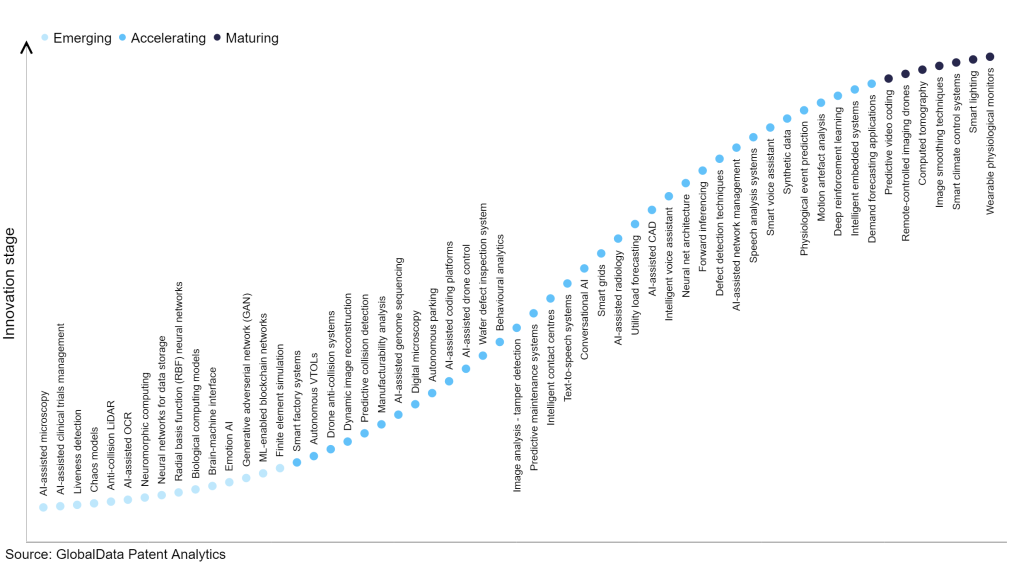The technology industry continues to be a hotbed of innovation, with activity driven by the increasing need for reliable and automated detection methods, the rising demand for secure digital platforms, and growing importance of technologies such as computer vision and deep learning architectures such as convolutional neural networks (CNNs) and recurrent neural networks (RNNs) for efficient and accurate image analysis and tamper detection. In the last three years alone, there have been over 3.6 million patents filed and granted in the technology industry, according to GlobalData’s report on Innovation in Artificial Intelligence: Image analysis – tamper detection.
However, not all innovations are equal and nor do they follow a constant upward trend. Instead, their evolution takes the form of an S-shaped curve that reflects their typical lifecycle from early emergence to accelerating adoption, before finally stabilising and reaching maturity. Buy the report here
Identifying where a particular innovation is on this journey, especially those that are in the emerging and accelerating stages, is essential for understanding their current level of adoption and the likely future trajectory and impact they will have.
300+ innovations will shape the technology industry
According to GlobalData’s Technology Foresights, which plots the S-curve for the technology industry using innovation intensity models built on over 2.5 million patents, there are 300+ innovation areas that will shape the future of the industry.
Within the emerging innovation stage, finite element simulation, ML-enabled blockchain networks and generative adverserial network (GAN) are disruptive technologies that are in the early stages of application and should be tracked closely. Demand forecasting applications, intelligent embedded systems, and deep reinforcement learning are some of the accelerating innovation areas, where adoption has been steadily increasing. Among maturing innovation areas are wearable physiological monitors and smart lighting, which are now well established
Innovation S-curve for artificial intelligence in the technology industry

Image analysis - tamper detection is a key innovation area in artificial intelligence
Image analysis for tamper detection involves utilising automated image-processing techniques to identify indications of tampering or manipulation in digital photographs. This encompasses alterations made to the image content, such as editing or cropping, as well as modifications to the associated metadata like the camera's EXIF data. The purpose of tamper detection is to uphold the integrity and authenticity of images, particularly those presented as evidence.
GlobalData’s analysis also uncovers the companies at the forefront of each innovation area and assesses the potential reach and impact of their patenting activity across different applications and geographies. According to GlobalData, there are 20+ companies, spanning technology vendors, established technology companies, and up-and-coming start-ups engaged in the development and application of image analysis - tamper detection.
Key players in image analysis - tamper detection – a disruptive innovation in the technology industry
‘Application diversity’ measures the number of different applications identified for each relevant patent and broadly splits companies into either ‘niche’ or ‘diversified’ innovators.
‘Geographic reach’ refers to the number of different countries each relevant patent is registered in and reflects the breadth of geographic application intended, ranging from ‘global’ to ‘local’.
Patent volumes related to image analysis for tamper detection
Source: GlobalData Patent Analytics
Digimarc is a leading patent filer in image analysis for tamper detection. The company’s patents in this space are mostly related to digital watermarking and data hiding.
One of the claims recites a smartphone comprising a camera to capture video of a display that is rendering video, in which the video comprises a first watermark signal embedded in a first portion of the data, a second watermark signal embedded in a second portion of the data, and a third watermark signal embedded in a third portion of the data, in which at least two of the three watermark signals are inversely related to one another.
The smartphone also has electronic memory for buffering the captured video, one or more electronic processors programmed for applying a first perspective distortion to the data representing the captured video to yield first perspective distorted video and analysing the first perspective distorted video to detect digital watermarking.
If digital watermarking is not detected, a second perspective distortion video is obtained and analysed to detect digital watermarking.
Other prominent patent filers in the space include Canon and Alphabet.
By geographic reach, International Business Machines (IBM) leads the pack, followed by Naver and Graphic Security Systems. In terms of application diversity, Janus Technologies holds the top position, followed by Dell Technologies and IBM.
Image analysis, specifically in tamper detection, has revolutionised the field of digital forensics and security. It involves the application of artificial intelligence algorithms to analyse and identify image manipulations, ensuring the integrity and authenticity of digital visual content.
To further understand how artificial intelligence is disrupting the technology industry, access GlobalData’s latest thematic research report on Artificial Intelligence (AI) – Thematic Intelligence.
Data Insights
From

The gold standard of business intelligence.
Blending expert knowledge with cutting-edge technology, GlobalData’s unrivalled proprietary data will enable you to decode what’s happening in your market. You can make better informed decisions and gain a future-proof advantage over your competitors.







